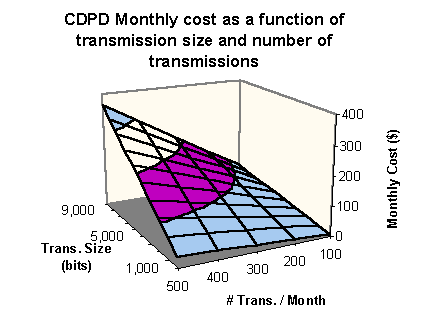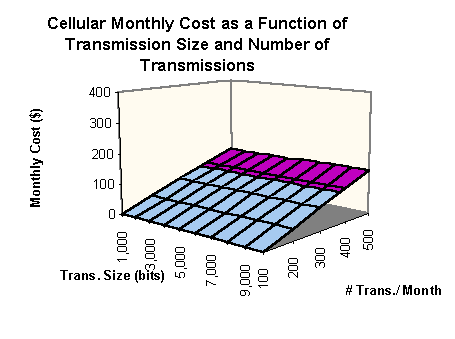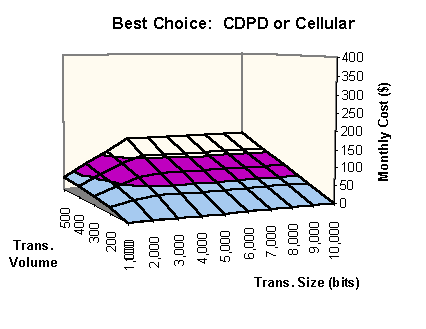CDPD and Cellular
Cost Comparison by Cost Driver
CDPD and analog cellular can both deliver 9600bps data rates for data transmission. It may seem, then, that the two services may have significant overlap in clientele. Our analysis demonstrates that individuals seeking thses services would be well served to closedly examine their usage requirements. In this analysis, we focus in on the usage costs for the two services. On the surface, the main cost driver in the recurring monthly costs are the usage costs. The following chart outlines the costs involved.

When we performed a straight break even analysis on the two technologies, we found that as usage increased, measured by bits transmitted per month, analog cellular with a cellular modem invariably won out. What we had overlooked in the analysis was the fact that any transmission in the cellular model, whether it takes two seconds or takes 59 seconds will be billed for a full minute. CDPD, on the other hand, bills for usage based on the number of 10-Byte packets transmitted. This analysis varies the size of a transmission in bits and the number of transmissions of that size performed in a month as a basis for the analysis. In this way, CDPD is placed back on even footing with cellular technologies: CDPD is designed to support short transmissions like email that require few packets to transmit. In this way, the several seconds that a transmission requires will not cost the user the full minute that cellular technologies would bill.
The following graphic depicts monthly usage fees for CDPD service as a function of both transmission size in bits and the number of transmissions in a month.

In examining the previous graphic, it becomes plain that CDPD is well positioned to deliver a large number of small transmissions in a month. This fact is made even more clear when compared to the cost of delivering the same number of small transmissions over analog cellular. The following graphic shows the relationship between monthly usage fees for analog cellular as a function of both transmission size in bits and the number of transmissions per month.

There is an amazing difference between the two graphics. Analog cellular is completely insensitive to the sizes of transmissions examined here. All of these transmissions would occur in less than one minute. It would require a transfer greater than 72 KB, ignoring call set up and disconnect, to take more than one minute. It is the granularity of the usage that underpins the difference between the two.
CDPD is clearly well positioned to deliver services where the usage can be characterized by a large volume of small transmissions. There are also a number of service plans for CDPD which might be able to make it even more competitive. With these plans, the monthly fee for service is higher but the per-packet rate drops dramatically from .0058 to .0019. For the service plans compared here, the best choice between the two can be judged by the nature of the expected traffic. The following graphic illustrates this clearly: it is a synthesis of the two previous graphics with the lower monthly fee selected. Where the constant slope of the cellular is interrupted and drops off to the left, CDPD is more competitive. In this case, producing a break-even analysis was more difficult: instead of a break-even point resulting, a break-even curve results from the analysis. That curve would be defined by the edge between the two systhesized surfaces.

Cost Analysis




